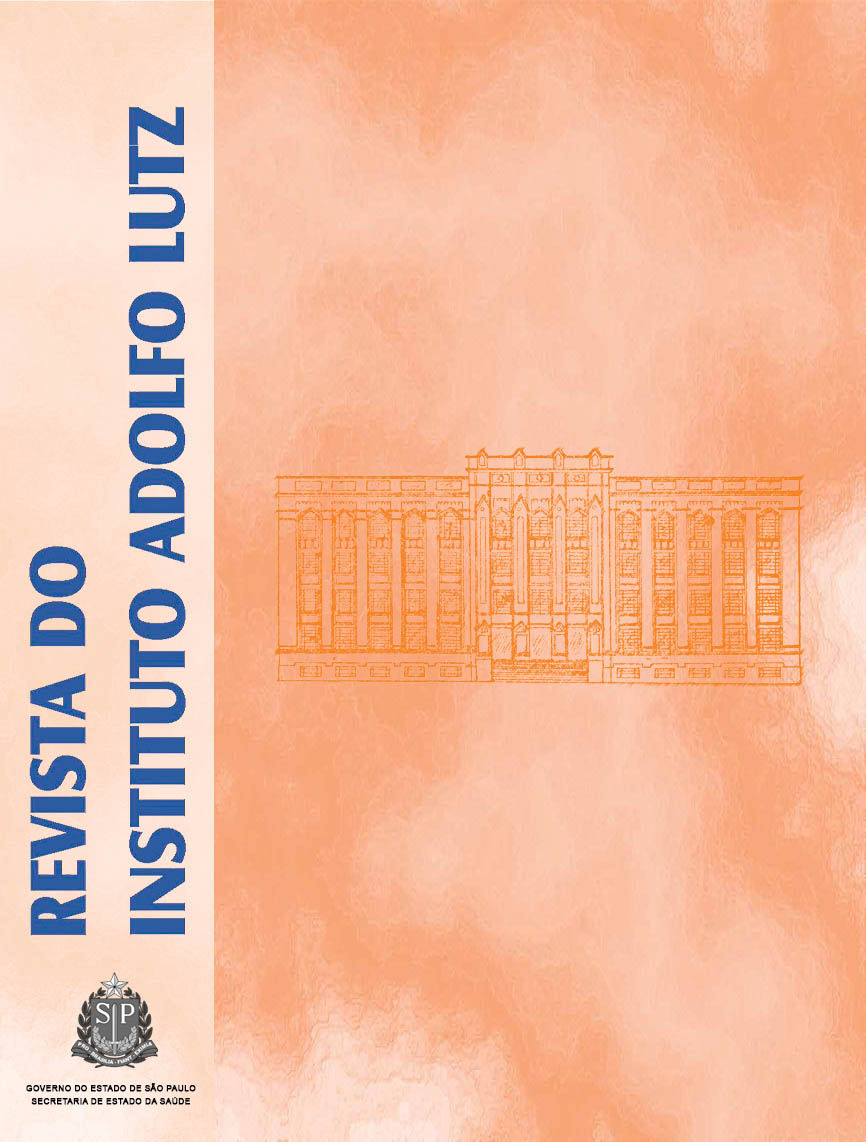Abstract
The objective of the present trial was to evaluate the thermal resistance of S. Enteritidis, S. Panama and S. Infantis, which were experimentally inoculated into the reconstituted infant milk formula. Samples of contaminated reconstituted milk were submitted to 60º, 70º, and 80ºC in a water - bath for 5 minutes. Salmonella spp. quantification was performed by means of Most Probable Number (MPN) technique. After thermal treatment at 60ºC, the mean count reductions in population of S. Enteritidis, S. Panamá, and S. Infantis were equal to 5.13, 4.63, and 4.82 log cycles, respectively. In heating at 70ºC, the means reductions were 6.42, 5.56, and 6.56 log cycles, respectively. At 80ºC there was no recovery of Salmonella spp. from analysed samples. Tukey's multiple comparison analysis showed that there were no significant differences on thermal resistance of three Salmonella strains at 60ºC and 70ºC. The present study showed that the treatments at 60º and 70ºC for 5 minutes were not enough to eliminate all Salmonella spp. population (106 MPN/mL) experimentally inoculated into the infant milk, showing the importance of the precautions during the milk manufacturing and manipulation steps, which were considered critical control points in preparing these foods.
References
1. Fantasia MR, Filetici E. Salmonella Enteritidis in Italia. Int J Food Microbiol 1994; 21: 7-13.
2. Notermans S, Borgdorff MA. Global Perspective of Foodborne Disease. JFood Prot 1997; 60 (11): 1395-9.
3. Centers for Disease Control and Prevention (CDC). Preliminary Food Netdata on the incidence of infection with pathogens transmitted commonly through food – 10 sites, United States, 2004. Available from: www.cdc.gov/mmwr/preview/mmmwrhtml/mm5414a2.htm. Acesso: 10/11/2005.
4. Centro de Vigilância Epidemiológica (CVE). Divisão de Doenças de Transmissão Hídrica e Alimentar. INFORME - NET DTA – Informações sobre Doenças Transmitidas por Água e Alimentos. Disponível em: http://www.cve.saude.sp.gov.br/htm/hidrica/dta_estat.htm. Acesso em: 01//11/2005.
5. Franco BDGM, Landgraf M. Microrganismos patogênicos de importância em alimentos. In: Franco BDGM, Landgraf M, editores. Microbiologiados Alimentos. São Paulo: Ed Atheneu; 2002, p. 55-60.
6. Varnam AH, Evans MG. Salmonella. In: Varnam AH, editor. Foodborne Pathogens. St. Louis: Mosby Year Book; London: Wolfe, 1991; p. 51-85.
7. Jakabi M et al. Observações laboratoriais sobre surtos alimentares de Salmonella spp., ocorridos na grande São Paulo, no período de 1994 a1997. Rev Inst Adolfo Lutz 1999; 58(1): 47-51.
8. Centers for Disease Control and Prevention (CDC). Salmonella serotype Tennessee in powdered milk products and infant formula – Canada andUnited States, 1993. Available from: www.cdc.gov/mmwr/preview/mmmwrhtml/00021081.htm. Acesso: 10/11/2005.
9. Bornemann R, Zerr DM, Heath J, Koehler J, Grandjean M, Pallipamu R, Duchin J. An outbreak of Salmonella serotype Saintpaul in a children’shospital. Infect Control Hosp Epidemiol 2002; 23: 671-6.
10. Eurosurveillance. Preliminary report of an International outbreak of SalmonellaAnatum infection linked to an infant formula milk, 1997. Available from:www.eurosurveillance.org/em/v02n03/0203-224.asp. Acesso: 10/11/2005.
11. Ruiz J, Nunez ML, Sempere MA, Diaz J, Gomez J. Systemic infections inthree infants due to a lactose-fermenting strain of Salmonella Virchow.Eur J Clin Microbiol Infect Dis 1995; 14: 454-6.
12. Rowe B et al. Salmonella Ealing infections associated with consumptionof infant dried milk. Lancet 1987; 2 (8564): 900-3.
13. Park et al. Salmonellaenterica serovar London infections associated withcomsumption of infant formula. Yonsei Med J 2004; 45: 43-8.
14. Word Heath Organization. Enterobacter sakazakii and othermicroorganisms in powdered infant formula. Microbiological RiskAssessment Series n° 6. Available from: www.who.int/foodsafety/publications/micro/mra6/en/ Acesso: 10/11/2005.
15. Caric M. Concentrated and dried dairy products. In: Dairy Science andTechnology Handbook vol.2. New York: VCH Publishers Inc; 1993.
16. Wu FM, Beuchat LR, Doyle MP, Mintz ED, Wells JG, Swaminathan B.Survival and growth of Shigellaflexneri, Salmonella enterica serovarEnteritidis, and Vibriocholerae O1 in reconstituted infant formula. Am JTrop Med Hyg 2002; 66: 782-6.
17.Salles RK, Goulart R. Diagnóstico das condições higiênico-sanitárias emicrobiológicas de lactários hospitalares. Rev Saúde Pública 1997; 31: 131-9.
18. Santos MIS, Tondo EC. Determinação de perigos e pontos críticos decontrole para implantação de sistema de análise de perigos e pontos críticosde controle em lactário. Rev Nutr Campinas 2000; 13: 211-22.
19. Edelson-Mammel SG, Buchanan RL. Thermal inactivation of Enterobactersakazakii in rehydrated infant formula. J Food Prot 2004; 67: 60-3.
20. International Organization for Standardization (ISO). Microbiology –General guidance for the detection of Salmonella. Intern. Org. forStandardization6579, Geneva, Switzerland, 2002.
21. Peeler JT, Houghtby GA, Rainosek AP. The most probable numbertecnhique. In: Vanderzant C, Splittstroesser DF, editors. Compendium ofmethods for the microbiological examination of foods 3rd. Washington (DC):APHA; 1992, p. 105-20.
22. Pessôa GVA, Silva EAM. Meios de rugai e lisina-motilidade combinados em um só tubo para a identificação presuntiva de enterobactérias. Rev InstAdolfo Lutz 1972; 32: 97-100.
23. Forsythe SJ. Aspectos básicos. In: Forsythe SJ, editor. Microbiologia da Segurança Alimentar. Porto Alegre (RS): Artmed; 2002, p.28-30.
24. Quintavalla S, Larini S, Mutti P, Barbuti S. Evaluation of the thermalresistance of different Salmonella serotypes in pork meat containing curingadditives. Int J Food Microbiol 2001; 67: 107-14.
25. MINITAB for windows [ Minitab- Inc, USA.] Versão 13.31, 2000. CD-rom
26. Jay JM. Conservação de alimentos por altas temperaturas e características de microrganismos termofílicos. In: Jay JM, editor. Microbiologia deAlimentos 6a ed. Porto Alegre: Artmed; 2005, p 365 – 85.
27. Mañas P, Pagán R, Sala FJ, Condón S. Low molecular weight milk whey components protect Salmonella Senftenberg 775W against heat by amechanism involving divalent cations. J Appl Microbiol 2001; 91: 871-7.
28. Robertos D. Bacteria of public health significance in meat microbiology. Brown, MH Ed. London and New York: Applied Science Publishers, 1982.
29. Nazarowec-White M, Farber JM. Thermal resistance of Enterobacter sakazakiiin reconstituted dried-infant formula. Lett Appl Microbiol 1997; 24: 9-13.

This work is licensed under a Creative Commons Attribution 4.0 International License.
Copyright (c) 2006 Instituto Adolfo Lutz Journal
